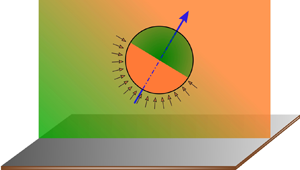Article contents
Thermotactic navigation of an artificial microswimmer near a plane wall
Published online by Cambridge University Press: 03 February 2023
Abstract

Despite significant advances in the field of man-made micro- and nanomotors, it remains a challenge to precisely control their motion in bounded environments. Here, we present a theoretical analysis of a thermally activated micromotor near a plane wall under the action of a background linear temperature field. The coupling between the autonomous and field-directed motions has been resolved using a combined analytical–numerical framework comprising general solutions in bispherical coordinates and the reciprocal theorem for creeping flows. Results reveal giant augmentation in swimming speeds, the controlling parameter zones for positive and negative thermotaxes and the flexibility of steering perpendicular to the field gradient for an isolated micromotor. Boundary-instigated thermo-fluidic modulations at different levels of confinements and preferential orientations cause directional switching of both the vertical translation and rotation parallel to the wall, thereby drastically altering the phase portraits of the swimmer dynamics. Contrasting trajectory characteristics, e.g. escape, attraction, are partitioned by unstable separatrices in the phase portraits, while competitive repulsion (attraction) after attraction (repulsion) characteristics emerge for different relative field strengths  $\mathcal {S}$ and gradient orientations
$\mathcal {S}$ and gradient orientations  $\theta _T$. Below
$\theta _T$. Below  $\mathcal {S}=0.25$, highly counter-intuitive trajectories result when the micromotor is initially launched from an overlapping escape zone. Moreover, external-field-assisted microswimming can uniquely tune the directionality of wall-parallel translation, broadening the scope of dynamic regulation of self-propulsion. Thus, providing insights into a precisely controlled fuel-free actuation of micromotors near a physical obstacle, the present study stands as a step toward addressing the increasing demand for successful implementation of micromotors in futuristic clinical and environmental applications.
$\mathcal {S}=0.25$, highly counter-intuitive trajectories result when the micromotor is initially launched from an overlapping escape zone. Moreover, external-field-assisted microswimming can uniquely tune the directionality of wall-parallel translation, broadening the scope of dynamic regulation of self-propulsion. Thus, providing insights into a precisely controlled fuel-free actuation of micromotors near a physical obstacle, the present study stands as a step toward addressing the increasing demand for successful implementation of micromotors in futuristic clinical and environmental applications.
JFM classification
- Type
- JFM Papers
- Information
- Copyright
- © The Author(s), 2023. Published by Cambridge University Press
References
REFERENCES
- 5
- Cited by



